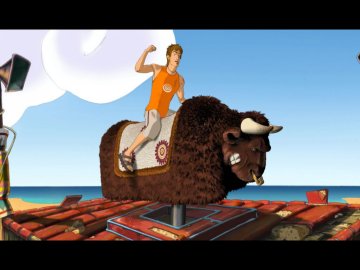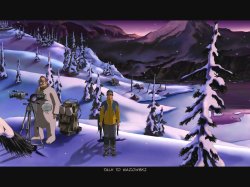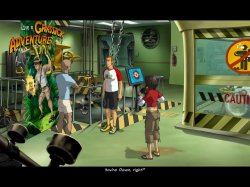|
Runaway 2: The Dream of the Turtle
 Gordon's preview reckoned that we were all in for a rollicking good time with the final product and I wholeheartedly confirm that that is indeed the case. If slightly bizarro point and click inventory quests are your thing, then Runaway 2: The Dream of the Turtle can't fail to please. Gordon's preview reckoned that we were all in for a rollicking good time with the final product and I wholeheartedly confirm that that is indeed the case. If slightly bizarro point and click inventory quests are your thing, then Runaway 2: The Dream of the Turtle can't fail to please. I first came across Pendulo studios via Hollywood Monsters, a game released only in Spanish but which clearly paved the way for the wacky Runaway: A Road Adventure, to which this game is the sequel. It's fair to say that, whilst the approach has remained largely the same, each game has built on the strengths of the one before it, with excellent results.
Runaway 2: The Dream of the Turtle starts with some early morning lovin', followed with Brian forcibly throwing Gina from a plane. Not surprising perhaps, given that he ran her over in the first game. If that isn't enough though, she gets shot on the way down. Brian meanwhile ends up lost in a jungle. Some days it pays to stay in bed.
Needless to say, Gina is the initial object of your quest, but don't be surprised if you feel further away by the time you have played all 6 chapters than when you started. What starts on a Hawaiian island, takes you to Alaska and then to the middle of the ocean, and passes through a military base, a pirate ship and a theory about polar bears on the way. Despite the title, turtles are few and far between although the dream is explained. It involves aliens, as is usually the way with turtles.
Oh, and there are spiders. They belong to an evil woman called Tarantula.
 The animation is top notch. Runaway 2: The Dream of the Turtle uses 2D backgrounds and 3D characters and objects to produce a cinematic feel. The detail in the scenes is enormous, and the many cutscenes, whilst a little more muted in colour by comparison, are fluid and dynamic. The underwater scenes stand out, particularly when Brian and his companion mini-sub explore a sunken galleon. The lighting is exquisite as they enter the wreck, resulting in a realism hard to ignore.
Gordon noted the ambient sounds in his preview, all the more prominent, as voices had not been added at that stage. The sounds in the final product are no less crisp and clear despite the voices being present, from the scrunch of feet in the snow to the ting of boots on metal.
Indeed, all the little things have been admirably done. Alaska stands out. Brian's breath comes out in little clouds, footprints appear as you trudge across the snowy hillsides and then fade as the snow falls. Shadows, too, are complete throughout the game, and are particularly impressive when you have a headshot of someone talking in a cutscene.
Peppered throughout the proceedings are some little acknowledgements of various adventure games, movies, and even just the adventure concept itself. Brian gives a nice little spiel on the essence of adventure, and at one point explains just how he managed to get an entire treasure trove into his trousers. He plays Greek chorus at times, drawing you into his confidence or just suggesting that you wait while he catches his breath, or that you turn away while he engages in some gruesome deed. Wait too long though, and he'll start to fidget, eventually looking at you and shrugging his shoulders. It all adds to the feeling of active participation.
The 6 chapters in Runaway 2: The Dream of the Turtle are discrete in terms of "puzzling". The inventory gets cleaned of redundant items as anything you don't need in the next chapter is jettisoned. If your disk space is at a premium, you can do a chapter install, and at the end of each chapter, the game will automatically delete the completed one and load the next. It takes a few minutes, but as you never need to go back the deletion doesn't matter. If you have the disk space though, a full install prevents these loads and helps speed up in-game loads. There is usually a short load with each scene change.
This is an inventory quest through and through. There are two small quizzes (both solvable by trial and error) and one non-inventory puzzle, involving 4 one-legged pirates and only one peg leg. It isn't new, but is worth working out, and can again be solved by trial and error if need be. The rest is exclusively find and then use the right item in the correct way. The animation is top notch. Runaway 2: The Dream of the Turtle uses 2D backgrounds and 3D characters and objects to produce a cinematic feel. The detail in the scenes is enormous, and the many cutscenes, whilst a little more muted in colour by comparison, are fluid and dynamic. The underwater scenes stand out, particularly when Brian and his companion mini-sub explore a sunken galleon. The lighting is exquisite as they enter the wreck, resulting in a realism hard to ignore.
Gordon noted the ambient sounds in his preview, all the more prominent, as voices had not been added at that stage. The sounds in the final product are no less crisp and clear despite the voices being present, from the scrunch of feet in the snow to the ting of boots on metal.
Indeed, all the little things have been admirably done. Alaska stands out. Brian's breath comes out in little clouds, footprints appear as you trudge across the snowy hillsides and then fade as the snow falls. Shadows, too, are complete throughout the game, and are particularly impressive when you have a headshot of someone talking in a cutscene.
Peppered throughout the proceedings are some little acknowledgements of various adventure games, movies, and even just the adventure concept itself. Brian gives a nice little spiel on the essence of adventure, and at one point explains just how he managed to get an entire treasure trove into his trousers. He plays Greek chorus at times, drawing you into his confidence or just suggesting that you wait while he catches his breath, or that you turn away while he engages in some gruesome deed. Wait too long though, and he'll start to fidget, eventually looking at you and shrugging his shoulders. It all adds to the feeling of active participation.
The 6 chapters in Runaway 2: The Dream of the Turtle are discrete in terms of "puzzling". The inventory gets cleaned of redundant items as anything you don't need in the next chapter is jettisoned. If your disk space is at a premium, you can do a chapter install, and at the end of each chapter, the game will automatically delete the completed one and load the next. It takes a few minutes, but as you never need to go back the deletion doesn't matter. If you have the disk space though, a full install prevents these loads and helps speed up in-game loads. There is usually a short load with each scene change.
This is an inventory quest through and through. There are two small quizzes (both solvable by trial and error) and one non-inventory puzzle, involving 4 one-legged pirates and only one peg leg. It isn't new, but is worth working out, and can again be solved by trial and error if need be. The rest is exclusively find and then use the right item in the correct way.
 Hotspots are relatively easy to find, but like most such games you may miss spotting one or two. Now and then you will probably resort to using everything you have everywhere you can in the hope of hitting the way forward. But given the large number of conundrums and the somewhat wacky nature of several solves, I thought the indications to most of the solutions were discernible.
Not always though. There was at least one solve which defied my analysis — it may be my less than subtle brain of course, but I know similar brains found it similarly defiant. There was also a sequence involving repetition that to me was not sufficiently indicated.
Be sure to look at everything. Some paths forward will not be triggered if you haven't noticed an item. It also pays to go back and look in things again. Brian might look in a box or case and find only those things he "needs" at the time. Sometime later, looking again would result in new finds. This aspect was one of the major frustrations in the early game for many players, but there is a lot less of it this time.
A couple of times Brian just needed to possess an item in order for another action to occur properly. This aspect can be confusing, and hard to explain without giving things away. Suffice to say that you (the player) can't use these items in the game world. Brian will use them when you try to perform a related action, assuming you have the item. If you don't, the related action will fail.
This leads to my main gripe, which is inconsistencies. I believe there needs to be an internal consistency in puzzles in order for the player not to be mislead, but in some several puzzles, Brian behaves differently than he does with the vast majority. If there is a clue that the puzzle "rules" are different, fair enough, but absent the clue it becomes frustrating. So by way of example, if Brian seemingly picks up absolutely everything he comes across, then if rummaging in a box is not going to result in finding everything available, he needs to indicate that in some way. If he doesn't, the player has no reason to look again.
As I said though, there are a huge number of conundrums and the inconsistencies only affect a small minority. All in all, I thought the conundrums were a great big thumbs up. Hotspots are relatively easy to find, but like most such games you may miss spotting one or two. Now and then you will probably resort to using everything you have everywhere you can in the hope of hitting the way forward. But given the large number of conundrums and the somewhat wacky nature of several solves, I thought the indications to most of the solutions were discernible.
Not always though. There was at least one solve which defied my analysis — it may be my less than subtle brain of course, but I know similar brains found it similarly defiant. There was also a sequence involving repetition that to me was not sufficiently indicated.
Be sure to look at everything. Some paths forward will not be triggered if you haven't noticed an item. It also pays to go back and look in things again. Brian might look in a box or case and find only those things he "needs" at the time. Sometime later, looking again would result in new finds. This aspect was one of the major frustrations in the early game for many players, but there is a lot less of it this time.
A couple of times Brian just needed to possess an item in order for another action to occur properly. This aspect can be confusing, and hard to explain without giving things away. Suffice to say that you (the player) can't use these items in the game world. Brian will use them when you try to perform a related action, assuming you have the item. If you don't, the related action will fail.
This leads to my main gripe, which is inconsistencies. I believe there needs to be an internal consistency in puzzles in order for the player not to be mislead, but in some several puzzles, Brian behaves differently than he does with the vast majority. If there is a clue that the puzzle "rules" are different, fair enough, but absent the clue it becomes frustrating. So by way of example, if Brian seemingly picks up absolutely everything he comes across, then if rummaging in a box is not going to result in finding everything available, he needs to indicate that in some way. If he doesn't, the player has no reason to look again.
As I said though, there are a huge number of conundrums and the inconsistencies only affect a small minority. All in all, I thought the conundrums were a great big thumbs up.
 Plot wise, well if it involves aliens, turtles, the military, sushi chefs and buck toothed scientists whose first thought is eating, it is going to be less than straightforward and a touch "out there". So go with the flow and have fun, which is the whole point.
There are several other significant characters in Runaway 2: The Dream of the Turtle, (including an assortment of friends from the first game) but somewhat disappointingly you only get to play Brian. It's a small thing, but would have added a little something. Perhaps next time.
There will indeed be a next time. And apparently more turtles. Cover your eyes if you don't want to know that this game ends "to be continued" with the plot unresolved.
There is a fair bit of dialogue, much of it just there for amusement and depth. You can talk to quite a few characters, and conversation trees will appear below the game screen. You need to repeat some of it to get to new topics, but can skip already heard dialogue with a mouse click. There was one conversation glitch involving a sandwich where I got information out of order.
Plenty of the dialogue is amusing and witty, some bawdy, some irreverent, and most players will find plenty to chuckle at. So too there are sight gags, an Indiana Jones homage being among my favourites. And several puzzle solves are surprising and extremely funny as a result. Amongst these, the poultry-raising spell stands out.
Voices and music are good to excellent. Some of the original songs are exceptional, and only very infrequently was the musical score cheesy. And even the over the top voices are in keeping with the particular character. Knife, the strangely named Australian surfer from Byron Bay, was the only voice I didn't like; he sounds like he is trying too hard to affect the Aussie twang. After all, we don't really talk like that do we?
Playing the game is extremely simple. Left and right click does everything, the inventory and menu screens accessed by icons above the game window. Everything you can do in the options menu is on one single screen, including subtitles, volume, and some graphic tweaking. Saving produces a snapshot of where you are up to, making identification easy. Brian won't run (lazy bugger) but a double click on a scene exit will leap him to the next scene. Game screens are a mix of static screens (ie what you see is all there is) and scrolling screens (so be sure to explore the edges of every screen).
Runaway 2: The Dream of the Turtle gave me a lengthy amount of great fun. I prefer more puzzles (as opposed to inventory conundrums) in my games as a rule but didn't miss them here. It's bright, it's breezy, it's a great bit of fun — what more can you ask for!
See the metzomagic.com Runaway 2: The Dream of the Turtle walkthrough. Plot wise, well if it involves aliens, turtles, the military, sushi chefs and buck toothed scientists whose first thought is eating, it is going to be less than straightforward and a touch "out there". So go with the flow and have fun, which is the whole point.
There are several other significant characters in Runaway 2: The Dream of the Turtle, (including an assortment of friends from the first game) but somewhat disappointingly you only get to play Brian. It's a small thing, but would have added a little something. Perhaps next time.
There will indeed be a next time. And apparently more turtles. Cover your eyes if you don't want to know that this game ends "to be continued" with the plot unresolved.
There is a fair bit of dialogue, much of it just there for amusement and depth. You can talk to quite a few characters, and conversation trees will appear below the game screen. You need to repeat some of it to get to new topics, but can skip already heard dialogue with a mouse click. There was one conversation glitch involving a sandwich where I got information out of order.
Plenty of the dialogue is amusing and witty, some bawdy, some irreverent, and most players will find plenty to chuckle at. So too there are sight gags, an Indiana Jones homage being among my favourites. And several puzzle solves are surprising and extremely funny as a result. Amongst these, the poultry-raising spell stands out.
Voices and music are good to excellent. Some of the original songs are exceptional, and only very infrequently was the musical score cheesy. And even the over the top voices are in keeping with the particular character. Knife, the strangely named Australian surfer from Byron Bay, was the only voice I didn't like; he sounds like he is trying too hard to affect the Aussie twang. After all, we don't really talk like that do we?
Playing the game is extremely simple. Left and right click does everything, the inventory and menu screens accessed by icons above the game window. Everything you can do in the options menu is on one single screen, including subtitles, volume, and some graphic tweaking. Saving produces a snapshot of where you are up to, making identification easy. Brian won't run (lazy bugger) but a double click on a scene exit will leap him to the next scene. Game screens are a mix of static screens (ie what you see is all there is) and scrolling screens (so be sure to explore the edges of every screen).
Runaway 2: The Dream of the Turtle gave me a lengthy amount of great fun. I prefer more puzzles (as opposed to inventory conundrums) in my games as a rule but didn't miss them here. It's bright, it's breezy, it's a great bit of fun — what more can you ask for!
See the metzomagic.com Runaway 2: The Dream of the Turtle walkthrough.
Copyright © Steve Ramsey 2007.
All rights reserved.
System Requirements:
Windows 98/ME/2000/XP, Pentium IV 1.6 Ghz / Athlon 1600+, 128 MB RAM (256 MB for Win 2000/XP), 32 MB DirectX 9-compliant video card (min 1024x768 16Bit), DirectX 9-compliant sound card, DirectX 9 or higher (included on disc), 2x DVD-ROM, 2.5 GB free hard drive space (for minimal install), Windows-compatible keyboard and mouse
|

